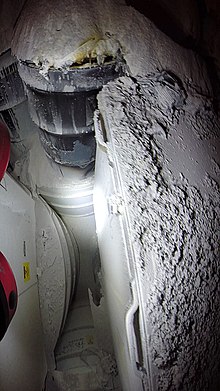Waste Isolation Pilot Plant
The Waste Isolation Pilot Plant ( WIPP ) is a repository for radioactive waste that was built in a salt formation near Carlsbad in the US state of New Mexico . The facility is used to dispose of waste with a high content of alpha emitters (so-called transuranic waste ).
Salt formations have been considered for radioactive waste disposal in the United States since 1955. The construction of the WIPP began in 1980. In March 1999 the facility went into operation with the first delivery of radioactive waste from Los Alamos National Laboratory . Since then, the transuranic waste from nine US facilities dealing with military tasks ( Rocky Flats , Los Alamos National Laboratory, Idaho National Laboratory , Hanford Site and others) have been stored there at a depth of around 650 m . The storage area consists of eight fields (panels), each with seven section chambers (rooms). The storage capacity is around 180,000 m³. A total of around 300 million GBq are to be stored, but the activity is not limited to transuranium elements.
WIPP is located in a very sparsely populated area, the location province of Eddy County has a population density of 5 people per square kilometer.
For WIPP, plans were updated in 2004 that were originally created for the other US nuclear waste disposal site, Yucca Mountain in Nevada . As early as 1981, a working group had drafted a concept based on the principles of so-called atomic semiotics to warn people over many generations about the dangers of nuclear waste . For this purpose, a large-scale facility is to be built on the surface above the repository: The design provides for 32 monoliths that form a square, inside which 3-kilometer-long earth walls enclose 16 further monoliths. These read in English, Spanish, Russian, French, Chinese, Arabic and Navajo: This is where dangerous radioactive waste is located. In no case dig or drill. More detailed information is provided in the center along with comic-style illustrations, one above the ground, one in an underground chamber. The warning system is not to be installed until the repository is full and a hundred year cooldown period under the control of the US Department of Energy , after which the repository is to be sealed. This is scheduled for around 2133. It is therefore completely unclear whether these plans will be implemented.
Critics complain, among other things, that the salt layer is not completely dry.
On February 14, 2014, increased levels of radioactivity were measured in the caverns when no one was working underground. Storage was stopped and the Department of Energy (DOE) began an investigation. This is the first incident involving the WIPP. It has been proven that 13 employees of the plant have inhaled americium or plutonium in very small quantities; medical measures were not considered necessary. Slightly increased values were found on the surface, well below the danger threshold. In the days that followed, the number of workers affected was corrected to 21. According to the DOE, the damage to one or more barrels due to a ceiling collapse in one of the chambers was initially considered as the cause. A connection with a truck fire at the facility, which occurred nine days before the event, was also considered. However, more recent findings indicate that incorrectly filling one of the barrels with radioactive waste could be responsible: To bind moisture, the barrels are usually filled with inorganic cat litter to prevent the radioactive ingredients from heating up too much. Apparently, in at least one case, organic cat litter was used, whereupon a chemical reaction occurred in one of the kegs and the seal on the keg was broken. The future of the plant could be jeopardized by the incident.
literature
- Marc Strout: Wasteland: the 50-year battle to entomb our toxic nuclear remains , The Verge, June 14, 2012
Individual evidence
- ↑ a b http://www.clarku.edu/mtafund/prodlib/card/Unsafe_Radwaste_Disposal_at_WIPP.pdf
- ^ National Geographic (D), July 2002
- ↑ Unless otherwise stated, the section on the plans from 2004 is based on: Reto U. Schneider : Warnschild für die Ewigkeit , in: NZZ Folio 7/2009
- ↑ http://www.cardnm.org/repository_a.html
- ↑ Los Angeles Times: Energy Department probes radioactive leak at New Mexico nuclear dump , February 18, 2014
- ^ The Wire: Workers Test Positive for Radiation After Leak at Nuclear Repository , February 28, 2014
- ↑ Ralf Streck: Accident in US nuclear storage facility intensifies doubts about the storage of nuclear waste in salt . Telepolis, April 5, 2014, accessed the same day.
- ↑ The Verge: Radioactive kitty litter may have ruined our best hope to store nuclear waste , 24 May 2014
Web link
Coordinates: 32 ° 22 ′ 18.2 " N , 103 ° 47 ′ 36.8" W.


